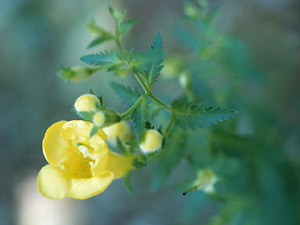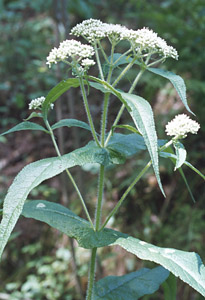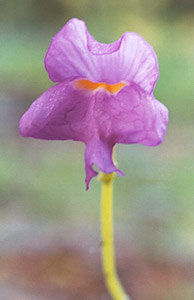
Fern-leaved False Foxglove, Snapdragon family (Scrophulariaceae), Native

|
In late summer, fern-leaved false foxglove (Gerardia pedicularia) makes itself known by its showy yellow trumpet-shaped blossoms. As the name suggests, the plant has lacy, fern-like leaves, unlike other false foxgloves. False foxgloves typically grow near oak trees, since they are partially parasitic on the roots of oaks.
Although they are in the same family, false foxgloves are not the same as cultivated foxglove
(Digitalis purpurea), a garden plant imported from Europe in colonial times and well known as the source
of digitalis, a powerful heart medicine. The flowers bear some resemblance to one another. False foxgloves
do not provide digitalis.
Boneset, Composite or Daisy family (Compositae), Native
 |
 |
 |
Boneset (Eupatorium perfoliatum) flowers in sunny, wet places in August, but the large plants are evident long before. Growing up to five feet tall, the hairy plants are distinguished by large, wrinkled leaves that look as if the plant stem is growing right through them. In reality, the leaves in a pair grow opposite one another and are joined at the base.
In bygone days, boneset tea was a well-known household remedy for fever and colds, in spite of its unpleasant
taste. People commonly gathered the plants and hung them to dry in attics and barns so families would have them
on hand in case someone fell ill. The name boneset may come from the plant's use in treating dengue fever,
also called bone-break fever because of the terrible pains that accompanied it. The leaves may also have been
part of the wrapping for broken bones.
Purple Bladderwort, Bladderwort family (Lentibulariaceae), Native


|

Purple bladderwort is a carnivorous aquatic plant with small purple flowers. Its underwater leaves are like
networks of filaments, with small pods--the trap-like bladders--scattered among them. Each bladder has a
trap door and a hair-like trigger. Tiny water organisms, such as insect larvae and tiny crustaceans, get
sucked into the bladder when the trap door opens suddenly. These creatures are digested in the
bladders, providing certain key nutrients, such as nitrogen, to the plant. The plants are only a few inches
high, but their underwater networks can be extensive.
| hide TOC | 
|
| Home / Contact | ||
Copyright © Anne A. Reid, 1999-2002. Photographs copyright © Garry K. Kessler, 1999-2002. | ||